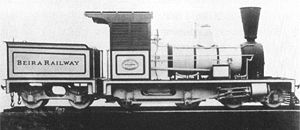BR class F2
| BR class F2 | |
|---|---|
|
BR class F2
|
|
| Numbering: | 4-9 |
| Number: | 6th |
| Manufacturer: | Falcon |
| Year of construction (s): | 1895 |
| Type : | 2'B n2 |
| Gauge : | 610 mm |
| Fixed wheelbase: | 1,651 mm |
| Total wheelbase: | 4,191 mm |
| Service mass: | 11.4 t |
| Service mass with tender: | 18.0 t |
| Driving wheel diameter: | 813 mm |
| Impeller diameter front: | 610 mm |
| Cylinder diameter: | 203 mm |
| Piston stroke: | 381 mm |
| Boiler overpressure: | 96.5 N / cm² |
| Grate area: | 0.42 m² |
| Radiant heating surface: | 2.32 m² |
| Tubular heating surface: | 18.58 m² |
| Train brake: | originally no, later suction air brake |
The vehicles of the class F2 of the Beira Railway (BR) were in Mozambique used Tender - steam locomotives with the wheel arrangement mm 2'B for a track width of the 610th According to AL Lawley one of the builders of the railway, they are often referred to as "Lawleys".
history
The first locomotive with track number 4 was supplied by the Falcon Engine and Car Works in 1895. It was the only one in the series that had the same driver's cab as the machines with the numbers 1 to 3 . Except for the undercarriage, it was also otherwise similar to the previous class, and the short two-axle tenders were also structurally identical. In essence, only the front coupling axle had been replaced by the bogie .
The locomotive turned out to be serviceable, and five more were ordered that same year (No. 5 to 9). However, there were no further deliveries of the series, because from 1896 only locomotives of the very similar, but somewhat larger, F4 class were procured.
Locomotive no. 5 fell from a bridge during a flood in 1895 and was fitted with a new four-axle tender as part of the repairs.
After the Beira Railway had been converted to Cape Gauge as early as 1900 , the still very young locomotives were stored in Bamboo Creek (now Vila Machado ). Some were sold to industrial companies and sugar cane plantations.
In 1915 the South African Railways (SAR) bought a total of 13 class F2 and F4 machines due to a war-related shortage of locomotives and finally put nine of them into service as class NG 6 , while the remaining four served as spare parts donors. Because the parts of different locomotives were combined with each other, the identity of the individual locomotives can no longer be precisely traced today. The machines NG 104 to 106 received frames from F2 locomotives, but F4 boilers and tenders. Nos. NG 105 and 106 were at least temporarily equipped with four-axle tenders, of which the Beira Railway had procured two.
Even during the war, the need for these comparatively inefficient locomotives died out and they were turned off again. In the 1920s and 1930s they were still used sporadically on various routes, including as construction locomotives. Two of the former F2s, NG 104 and 105, were sold to industrial companies in Rhodesia , NG 106 stayed in South Africa and was last used on a sugar cane plantation in the Northern Transvaal, where it received a new boiler in 1942 and was in use until 1959.
Whereabouts
The NG 106, restored by Sandstone Estates in South Africa, is in working order. It was restored in 2001 and 2002 and given the original green paintwork of the Beira Railway, remains of which had appeared during the restoration. Otherwise it corresponds to the state after the conversion at SAR, so it is a mixture of classes F2 and F4. The work number 233 was found during the work; At least the frame of the machine is that of the former No. 7 of the Beira Railway.
In 1961, a locomotive for the Railway Museum in Bulawayo was assembled from two locomotives, SAR NG 104 (probably ex-BR No. 5) and BR No. 19 (Class F4) . The unneeded parts of both locomotives were put together to form a second locomotive, which has been in a children's playground ever since. At least the frame of this example comes from the original F2.
literature
- Antony Baxter: The Two Foot Gauge Enigma - Beira Railway 1890-1900. Plateway Press, ISBN 1-871980-34-8
Individual evidence
- ↑ Illustration of No.NG 106
- ↑ a b Sandstone Heritage Trust ( Memento of the original from April 13, 2014 in the Internet Archive ) Info: The archive link was inserted automatically and has not yet been checked. Please check the original and archive link according to the instructions and then remove this notice.
- ↑ The two Lawleys in Bulawayo
